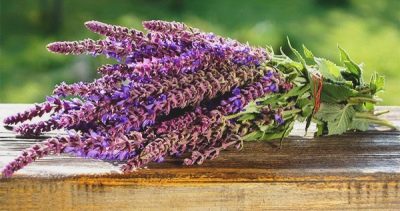Does sage help with fertility and how to take it?
In the treatment of infertility couples often use both traditional and alternative means. Sometimes folk remedies perfectly complement the treatment prescribed by the doctor and enhance the effect. One of these proven time and many generations of tools is sage. This amazing plant helps to improve reproductive health, gives strength, increases the chances of conceiving a baby. In this article we will tell you what properties the plant has and how to use it for the treatment of infertility for women and men.
About plant
Legend has it that the Virgin Mary herself asked for protection from the Lord, trees, grass and birds when she had to flee from Herod with little Jesus to Egypt. One plant answered the maternal request, which covered it with its blossoms from persecution. As a token of gratitude, Maria endowed sage with amazing healing properties, giving life and a second youth. Especially loved this plant among women. Recipes have long been known that helped them become mothers sooner.
This perennial shrub can reach 70 centimeters in height. There are about 900 species of sage, all of which are widely distributed throughout the world. Sage blooms with beautiful lilac flowers, its scent attracts a lot of insects, and is also highly appreciated by perfumers. However, wild sage is a rarity in Russia. Usually it is specially grown and cultivated.
In medicine, almost all parts of the plant are used - from flowers to leaves and stem. The shelf life of dried plant materials is not more than two years.
Composition
All parts of the plant - a real storehouse of nutrients. They are rich in flavonoids, essential oils, alkaloids. The special properties of sage are due to oleanolic and ursolic acids, tannins, as well as a high content of vitamins A, B, C. Of the mineral substances in the plant there are manganese, calcium, zinc, magnesium, and iron.
Benefits for women
For women, sage can do several good deeds at once: it not only strengthens and rejuvenates the female body, improves metabolism, but is also very useful for conception. That is what makes the plant a real doctor for infertility.
Female infertility can have a variety of reasons, but in most cases inflammatory processes of the reproductive organs, hormonal disturbances, and menstrual disorders are “guilty” of the inability to conceive a baby. Sage helps to cope with most problems quite successfully. It contributes to the production of estrogen, estradiol, without which the first phase of the menstrual cycle will not be complete - the follicles will not mature enough for subsequent ovulation.
The natural composition of the plant causes its anti-inflammatory properties, with many inflammatory processes in gynecology it is recommended to take drugs with sage. The healing properties of the subshrub help to restore the endometrium of the uterus, its alignment and healing, as well as the removal of puffiness.
Phytohormones, which are contained in sage, are almost identical in their chemical structure to human sex hormones; therefore, the herbal preparation is recommended to be drunk to normalize ovulation, to establish uniform and painless menstruation.
In certain doses, sage improves the quality of oocytes - female germ cells. In addition, sage has a mild sedative effect on the nervous system, and the systematic intake of drugs from this plant allows you to calm down, relieve stress, which is very helpful in the treatment of psychogenic infertility.
Too thin functional layer of the endometrium of the uterus prevents the normal implantation of a fertilized egg. Proper use of sage in the prescribed dosage allows the endometrium to “grow” by 4–5 mm, while some popular pharmaceutical preparations from the field of traditional medicine cannot guarantee a “gain” of more than 1-2 millimeters. This affordable plant wonder can be a good alternative to expensive pharmacies.
Douching with a decoction of sage helps to cope with cervical erosion. Infusion of sage leaves helps to improve the general state of health - the woman becomes more energetic, active, her hair and nails grow better, the condition of the skin improves.
How to take - treatment regimen
Despite the fact that sage is a herbal remedy, a woman must consult with a doctor before use. The fact is that a shrub, as a source of natural plant hormones, can enhance the effect of hormonal drugs prescribed for the treatment of infertility, and a hormonal imbalance will arise, which itself will become an additional obstacle to the cherished goal - pregnancy. The dosage should be calculated individually, based on data from laboratory analyzes of hormonal profile.
Most often, women who want to become mothers, sage is suitable in the form of decoctions, infusion, douching and tampons. Sometimes a combination of uses is recommended.
Regardless of the method chosen, a woman should start taking sage preparations only after the end of the next menstruation. At the time of monthly reception is canceled completely. The first day in the treatment regimen is the first day after the end of the menstrual bleeding.
Continue to take sage should be only until ovulation, that is, in the first phase of the cycle. Ovulation usually occurs in the middle of the cycle, with a 28-day cycle, it should be expected on the 14th day, at the 30-day cycle - on the 15th day, etc.
From the moment of ovulation from the reception of sage should be abandoned, because it increases the tone of the uterus, which is undesirable for the normal process of implantation of the ovum if fertilization took place.
If conception does not occur, a new course begins at the end of the next menstruation. If conception does not occur within three months, you should take a break for 1-2 months and try the treatment again.
How to brew?
A decoction of flowers and leaves of sage is recommended to take 3-4 times a day for 50-60 ml (individual dosage can be both higher and lower, we give only the average allowable dose). For the preparation of the broth will need no more than 15 grams of dry plant materials and a glass of water.
The crushed raw material is poured with a glass of boiled water, kept on a water bath or slow fire for no more than 3-4 minutes. After that, the broth should be allowed to cool, strain it with gauze or sieve, and then take in the prescribed dosage. You should not cook at once a large amount of decoction "in reserve". It is better to brew sage every day from a new portion of vegetable raw materials. So wonderful grass-assistant can reveal the maximum range of its medicinal properties.
To prepare the sage infusion, you can use both herbal raw materials collected by yourself and the pharmacy bag collection.The ratio of ingredients fully complies with the standards for the decoction - 15 grams of herbs per glass of water. Sage is brewed as described above, but does not boil or hold in a water bath, but is covered with a lid and left to infuse for a couple of hours. After filtering the infusion is ready to use. The dosage of infusion should be somewhat less than the dosage of broth, since the concentration of nutrients in the infusion is higher.
In case of inflammatory processes in gynecology, douching will help. For him, it is better to prepare a water infusion as described above. Douching should be done with liquid at room temperature twice a day - in the morning and in the evening.
In some cases, women can be shown therapeutic baths with the addition of infusion of sage. In this case, the amount of infusion is calculated by the formula - a glass of infusion for five liters of water. The duration of the treatment bath should not exceed 10-15 minutes.
Tampons soaked in water infusion of leaves and flowers of sage, injected into the vagina for 30 minutes before bedtime.
If an allergic reaction, skin rash, itching or swelling, food disorders (if the woman decided to drink the decoction or infusion) appears, the treatment should be stopped and the doctor should be consulted, individual intolerance of the components of the medicinal plant is possible.
Benefits for men
Of course, sage is not the best "male" grass to improve spermatogenesis, but it may well be present in the treatment of family infertility. Sage improves blood supply to the scrotum, which has a positive effect on the process of sperm production and maturation.
The plant improves the man’s well-being, after several days of administration, the representatives of the stronger sex begin to notice that they feel much better, and their sexual appetites grow noticeably, and their libido increases.
The reasons for the male factors of infertility are actually not so much - mechanical obstacles along the line of sperm following at the moment of ejaculation or insufficient amount-quality of seminal fluid.
Sage effectively improves the processes of spermatogenesis, which allows, in combination with other treatments prescribed by the urologist, to improve the composition of sperm, to improve the quality and quantity of spermatozoa that are mobile and capable of fertilization, and also gently removes some causes of impassability of the spermusculus.
Infusion and decoction for a man is prepared according to the same recipes as for a woman, only the dosage and treatment regimen is somewhat different. So, a man should take a decoction 55 ml twice a day, for example, in the morning and in the evening. Infusion can be taken twice a day, 50 ml or 110 ml once a day. It is much more convenient for many men employed at work to take medicine once.
Contraindications
Sage is not recommended for women with elevated levels of estradiol and estrogen. That is why it is so important to consult a doctor. Excess hormones would otherwise cause the opposite effect - pregnancy will be less likely, but body weight can “crawl” up.
Sage is not recommended for women and men who have problems with blood clotting. You can not drink sage also:
- women who have recently suffered childbirth or abortion;
- women whose amenorrhea (absence of menstruation) is long lasting (six months or more);
- women with polycystic ovaries or inflammatory diseases of the reproductive organs in the acute stage;
- women and men with tumors of any origin;
- for women who are not sure of their “position” - is there a pregnancy, you should not take sage, because when you carry a baby and breastfeeding, taking this medicinal plant is strictly prohibited;
- men who have recently undergone antibiotic or hormone therapy, as well as men with severe obesity.
Not every medicinal plant has such an impressive list of contraindications, and therefore we emphasize once again the need for prior consultation with a doctor. Do not assume that the sage plant is harmless. It is a mistake to think that herbs and flowers cannot harm the human body. It is also a mistake to completely replace the prescribed treatment with folk remedies.
Sage, although it has a large range of therapeutic effects, can not replace all existing drugs, and infertility can have a different genesis.
Reviews
According to women, sage shows high efficiency when planning pregnancy, especially in combination with linden. Many women prepare this herbal tea and drink it until ovulation. In the second half of the cycle, they recommend paying attention to drinks with other plants, for example, with a red brush or a boron uterus. Most of this combination of plants allowed to quickly become pregnant.
About the inefficiency of sage speak mostly women who are faced with the problem of infertility of unknown origin. After several courses of herbal therapy, they usually still decide on IVF.
In most cases, those who have been helped by sage claim that 2-3 courses of treatment were enough for a long-awaited pregnancy to occur. Some indicated that, apart from sage, at the time of planning they did not take any more drugs.
About what other grass can help with infertility, see the following video.































